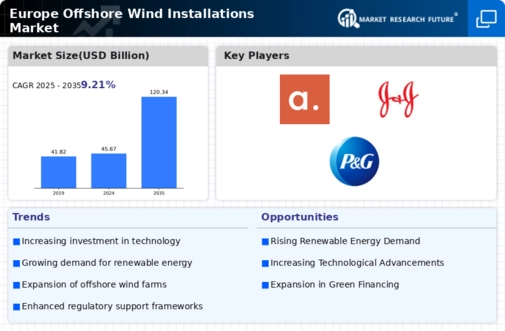Rising Energy Demand
The increasing global demand for energy, particularly in Europe, significantly influences the Global Europe Offshore Wind Installations Market Industry. As economies recover and industrial activities ramp up, the need for sustainable and reliable energy sources becomes paramount. Offshore wind energy presents a viable solution to meet this demand while reducing carbon emissions. European countries are investing heavily in offshore wind projects to diversify their energy mix and enhance energy security. This trend is expected to drive substantial investments in the sector, contributing to the anticipated growth of the market, which is projected to reach 120.34 USD Billion by 2035.
Market Growth Projections
The Global Europe Offshore Wind Installations Market Industry is projected to experience robust growth in the coming years. The market is expected to expand from 45.67 USD Billion in 2024 to 120.34 USD Billion by 2035, indicating a compound annual growth rate of 9.21% from 2025 to 2035. This growth trajectory reflects the increasing investments in offshore wind projects, driven by favorable government policies, technological advancements, and rising energy demand. The expansion of offshore wind capacity is likely to play a pivotal role in achieving Europe’s renewable energy targets and addressing climate change challenges.
Technological Advancements
Technological innovations play a crucial role in shaping the Global Europe Offshore Wind Installations Market Industry. The development of larger, more efficient turbines has led to increased energy output and reduced costs. For example, advancements in floating wind turbine technology allow for installations in deeper waters, expanding the potential for offshore wind farms. The integration of digital technologies, such as predictive maintenance and advanced data analytics, further optimizes operational efficiency. As a result, the market is projected to grow from 45.67 USD Billion in 2024 to 120.34 USD Billion by 2035, reflecting a compound annual growth rate of 9.21% from 2025 to 2035.
Government Policies and Incentives
The Global Europe Offshore Wind Installations Market Industry benefits significantly from supportive government policies and incentives aimed at promoting renewable energy. Various European nations have established ambitious targets for offshore wind capacity, with the European Union aiming for 300 GW by 2030. Such policies often include feed-in tariffs, tax incentives, and grants that encourage investment in offshore wind projects. For instance, the UK government has committed to a target of 40 GW by 2030, which is expected to drive substantial growth in the market. This supportive regulatory framework is likely to enhance investor confidence and stimulate further developments in the sector.
Investment Opportunities and Financing
The Global Europe Offshore Wind Installations Market Industry is witnessing a surge in investment opportunities, attracting both public and private financing. Institutional investors and energy companies are increasingly recognizing the long-term potential of offshore wind projects. Innovative financing models, such as green bonds and public-private partnerships, are being utilized to fund large-scale installations. This influx of capital is essential for the development of new offshore wind farms and the expansion of existing ones. As the market matures, the availability of diverse financing options is expected to enhance project viability and stimulate further growth in the sector.
Environmental Concerns and Climate Change
Growing awareness of environmental issues and climate change is a major driver for the Global Europe Offshore Wind Installations Market Industry. As nations strive to meet their climate commitments under international agreements, there is a strong push towards renewable energy sources. Offshore wind energy is recognized as a clean and sustainable alternative to fossil fuels, helping to mitigate greenhouse gas emissions. European countries are increasingly prioritizing the development of offshore wind farms as part of their climate action plans. This shift towards greener energy solutions is likely to accelerate investments in the offshore wind sector, further propelling market growth.













